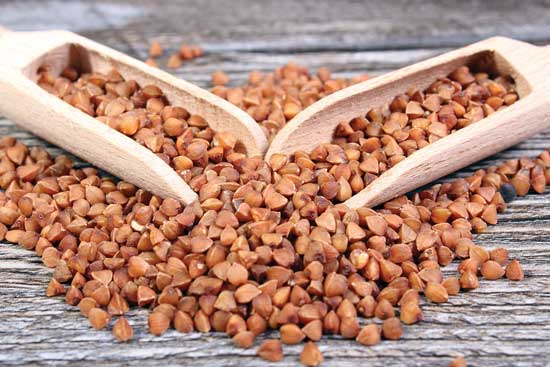Food systems for space travel; Putting clean label in perspective
NEWS
 Buckwheat, millet enhance wheat properties
Buckwheat, millet enhance wheat properties
Adding buckwheat and millet to wheat flour diversifies the properties of wheat while also enhancing the nutritional quality of the ingredient, according to a recent study that appeared in the Journal of Food Science.
Buckwheat and millet are known for their nutritional and functional qualities, but using them on their own or in too high a concentration can have detrimental effects on a product’s quality. Combining them with different grains such as wheat, however, can open up wider possibilities for using these ingredients to enhance the nutritional properties of products such as pastas. In this study, researchers investigated how adding buckwheat and millet flour affected wheat flour’s functionalities, including thermal, gelling, and rheological (pasting, dynamic oscillatory, and steady shear) properties. The additive/nonadditive behaviors of the flour in relation to the mixing ratio were mathematically explored in a quadratic model that accounted for nonlinear property changes.
Adding buckwheat and millet can increase nutritional properties of wheat-based products that lack nutrients and minerals, such as breads and noodles, according to Fan Zhu, one of the study’s authors. But since noodles experienced dough cracking when buckwheat and millet reached 60% and 40% of the flour blends, respectively, Zhu cautions exceeding a mixing ratio of 60%.
Building food systems for space travel
The types of foods available for crew members during space travel have expanded since their introduction in the 1960s, from simple tubes and cubes to freeze-dried pouches and rehydratable meats. When it comes to creating suitable food systems for travel to Mars, though, there are still a variety of challenges that will need to be met, according to Grace Douglas, advance food technology lead scientist at the Johnson Space Center, who presented a history of space food systems and gave insight into their future during an IFT webcast called “Evolution of the Space Flight Food System.”
Because a possible mission to Mars may last as long as 2.5 years, scientists must provide crew members with foods that will be nutritionally stable and remain palatable for at least five years. “The longer the mission in any exploration the more important the value attributed to food,” says Douglas; without consuming the proper number of calories, crew members may suffer decreases in weight and bone mass loss, as well as declines in cognition and performance.
Some of the challenges scientists face when creating food systems that meet these requirements include combating nutrient degeneration in foods over time, creating packaging with proper barrier properties, and finding processing methods that can maintain stability over time. According to Douglas, retort processing that is currently used with pouches works well for shorter missions, but there is greater nutrient loss and decreases in acceptability over the time Mars food would need to be stored. In addition, there is not currently a suitable packaging material that can maintain food quality over time, and the best-quality packaging that does exist cannot be used with alternative processing methods NASA is exploring, such as microwave. Overfortifying food to combat nutrient loss is not a viable option either, says Douglas; foods must contain the proper ratio of nutrients at all points of their shelf life.
Whatever the methods will be to create long-lasting shelf stability, the foods that crew members eat are very similar to those eaten on Earth, just in different forms; powdered coffee, reconstituted shrimp cocktail, and nuts are among the nearly 200 items found aboard the shuttles.
Click here to view the webcast. On-demand webcasts are free for IFT members.
Carrot pulp increases puffiness
Adding carrot pomace—the pulpy material leftover from juicing the vegetables—to cornstarch can increase the puffiness in extruded products, according to research published by IFT member and Washington State University assistant professor Girish Ganjyal in LWT - Food Science and Technology.
In the study, researchers experimented with pomace levels of 5, 10, and 15 grams/100 grams at feed moisture levels of 15, 22.5, and 30 grams/100 grams. The extrudate properties (expansion ratio, unit density, water solubility index, water absorption index, microstructure, and beta-carotene content) were examined to understand the role of the insoluble fiber in the carrot pomace on the extrusion process, specifically relating to expansion. The greatest expansion, or puffiness, was seen in the extrudates with 5 grams/100 grams carrot pomace inclusion at 15 grams/100 grams feed moisture; higher levels resulted in a significant decrease in expansion.
Adding pomace does not affect the product’s overall taste, and it can add fiber and nutrients while making use of a wasted byproduct. Ganjyal is continuing to research how the starch and fiber are interacting at the molecular level to find ways to increase pomace levels.
--- PAGE BREAK ---
 Acceptance of rice peptide in orange juice
Acceptance of rice peptide in orange juice
A rice bran–derived pentapeptide that has been shown to inhibit cancer cell growth was successfully incorporated into an orange juice beverage, according to a study in the Journal of Food Science. The peptide, which showed inhibition of human prostate cancer cells by 45% at 460 microgram per milliliter (µg/mL) concentration, was incorporated into spray-dried orange juice and reconstituted. The researchers measured degradation of the peptide over six-month storage; there was an approximately 10% degradation of the peptide at 620 µg/mL concentration under refrigerated conditions and 30% at ambient temperature, and greater degradation was seen when 240 or 460 µg/mL pentapeptide was used.
Consumer panelists liked the sensory aspect of the juice, as well as the color and mouthfeel, though their hedonic impression was slightly low due to the bitter note caused by the peptide. The researchers conclude that fortified orange juice has the potential to act as a functional food and believe that encapsulation of the peptide may help alleviate its structural instability as well as its bitterness, according to study author Navam S. Hettiarachchy. In addition, he says the peptide could work in a variety of beverages in dry powder forms.
Clean label important but undefined
Consumers do not have a real understanding of what “clean label” means to the food industry, but they do have specific claims they are looking for, according to FONA International’s “Understanding the Opportunity in Clean” webcast held on April 25.
Like natural, clean label is undefined, and for many consumers, a “clean label product” is still an industry concept, says Pamela Oscarson, consumer insights manager for FONA International. But that does not mean that consumers are not looking for the claims and attributes that many clean label products promote, namely omitting artificial ingredients in favor of simple ones and using verified supply chains that incorporate American-made sources when possible. Consumers may not understand clean label, but they understand the value of these products, says Tracy Cesario, director of corporate communications for FONA. She encourages companies to use different terminology, such as “nothing artificial” and “honest ingredients.”
The drivers that inspire consumers’ definition of “healthy” foods have also shifted, from low in fat and calories to foods that give them the ability to lead active lives. This shift spans income levels and is cross-generational, though Millennials continue to be early adopters. They are also more willing to pay more for these foods. Still, says Oscarson, taste and price remain top of mind for consumers when choosing foods; 58% of consumers aren’t willing to give up taste for health, she says.
Oscarson challenges formulators to take a proactive approach to creating clean label products, encouraging them to factor ingredient selection into product develop-ment rather than substituting un-desirable ingredients later. Cesario also encourages companies to have conversations with their suppliers about their definitions of clean and to determine which attributes must always appear on a product and which might be okay to adjust when suitable ingredients are not available.
News Bites
• AIDP signed an agreement with Plandaí Biotechnology to market and distribute Phytofare Catechin Complex to the functional foods and nutraceutical industries.
• Archer Daniels Midland Co. and National Foodworks Services launched the first annual Food Innovation Challenge, a contest designed to provide new food entrepreneurs with access to resources and industry mentors to evaluate their product ideas.
• Ardent Mills opened its state-of-the-art Ardent Mills Innovation Center in Denver.
• Aseptia announced John A. Hudson as executive vice-president and chief intellectual property officer.
• BENEO’S chicory root fiber received authorization from the EU Commission for a blood glucose health claim.
• Antioxidant supplier Camlin Fine Sciences opened a North American division in Urbandale, Iowa.
• DSM announced two major plant expansions in China to boost both gellan gum and pectin capacities, and it will establish a world-class Global Innovation Center for hydrocolloids adjacent to its gellan facility.
• Hershey acquired Ripple Brand Collective, a privately held company that owns the barkTHINS snacking chocolate brand.
• Mars Food announced a new global Health & Wellbeing Ambition campaign to create and promote healthier food choices and to encourage consumers to cook and share healthier meals with others.
• Nellson Nutraceutical named Jamie Better as the company’s CEO.
• Nestlé established the Nestlé Research Centre Asia in Singapore and invested in new technology at its factory in Hungary.
• Nominations are being accepted through June 30 for the Norman Borlaug Award for Field Research and Application. Click here for more information.
• Parabel USA and Barentz announced an exclusive worldwide distribution agreement for Parabel’s plant-based protein ingredients.
• Reckner, owner of The Institute for Sensory Research and Reckner Facilities, opened a state-of-the-art sensory and product testing facility in Harrison, N.Y.
• The Robert Mondavi Institute announced Forrest “Ryan” Dowdy as winner of the 2016 Arla Foods Graduate Fellowship.
• The U.S. Agency for International Development awarded Cornell University a $4.8 million, three-year grant to develop and disseminate genetically engineered eggplant in Bangladesh and the Philippines.
• The U.S. Dept. of Agriculture announced the availability of $6 million to fund research to address antimicrobial resistance; applications are due Aug. 3. Visit 1.usa.gov/24mRcI3. Click here to apply.
 Melanie Zanoza Bartelme, Associate Editor
Melanie Zanoza Bartelme, Associate Editor
[email protected]
